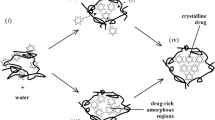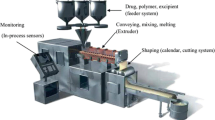Abstract
Formulations such as amorphous dispersions have been proposed to counter the ever present need to make drug products sufficiently soluble. However, a major concern with amorphous pharmaceuticals is physical instability, where the higher free-energy form will spontaneously revert to the more stable (and less soluble) crystalline form. Proposed mechanisms of amorphous pharmaceutical stabilization via solid dispersions are presented, as well as the analytical methods used to understand or monitor physical stability. This work focuses on differential scanning calorimetry, Raman and infrared spectroscopy, and powder X-ray diffraction, based on the general accessibility of these methods and abundant references in the pharmaceutical literature.
Similar content being viewed by others
References
Ku MS. Use of the biopharmaceutical classification system in early drug development. AAPS J. 2008;10(1):208–12.
Kauzmann W. The nature of the glassy state and the behavior of liquids at low temperatures. Chem Rev. 1948;43(2):219–56.
Kivelson D, et al. A thermodynamic theory of supercooled liquids. Physica A. 1995;219:27–38.
Edigers MD, Angell CA, Nagel SR. Supercooled liquids and glasses. J Phys Chem. 1996;100:13200–12.
Hancock B, Zografi G. Characteristics and significance of the amorphous state in pharmaceutical systems. J Pharm Sci. 1997;86(1):1–12.
Yu L. Amorphous pharmaceutical solids: preparation, characterization and stabilization. Adv Drug Discov Rev. 2001;48:27–42.
Hilden LR, Morris KR. Physics of amorphous solids. J Pharm Sci. 2004;93(1):3–12.
Bates S, et al. Analysis of amorphous and nanocrystalline solids from their X-ray diffraction patterns. Pharm Res. 2006;23(10):2333–49.
Matsumoto T, Zografi G. Physical properties of solid molecular dispersions of Indomethacin with poly(vinylpyrrolidone) and poly(vinylpyrrolidone-co-vinyl-acetate) in relation to indomethacin crystallization. Pharm Res. 1999;16(11):1722–8.
Chiou WL, Riegelman S. Pharmaceutical applications of solid dispersion systems. J Pharm Sci. 1971;60:1281–302.
Mooter GVd, et al. Physical stabilisation of amorphous ketoconazole in solid dispersions with polyvinylpyrrolidone K25. Eur J Pharm Sci. 2001;12:261–9.
Sairam M, et al. Poly(methylmethacrylate)-poly(vinyl pyrrolidone) microspheres as drug delivery systems: indomethacin/cefadroxil loading and in vitro release study. J Appl Polym Sci. 2007;104:1860–5.
Tantishaiyakul V, Kaewnopparat N, Ingkatawornwong S. Properties of solid dispersions of piroxicam in polyvinylpyrrolidone K-30. Int J Pharm. 1996;143:59–66.
Lovrecich M, et al. Effect of ageing on the release of indomethacin from solid dispersions with Eudragits. Int J Pharm. 1996;131:247–55.
Taylor LS, Zografi G. Spectroscopic characterization of interactions between PVP and indomethacin in amorphous molecular dispersions. Pharm Res. 1997;14:1691–8.
Taylor LS, Zografi G. Sugar–polymer hydrogen bond interactions in lyophilized amorphous mixtures. J Pharm Sci. 1998;87(12):1615–21.
Lu Q, Zografi G. Phase behavior of binary and ternary amorphous mixtures containing indomethacin, citric acid, and PVP. Pharm Res. 1998;15(8):1202–6.
Shamblin SL, Taylor LS, Zografi G. Mixing behavior of colyophilized binary systems. J Pharm Sci. 1998;87(6):695–701.
Khougaz K, Clas S-D. Crystallization inhibition in solid dispersions of MK-0591 and poly(vinylpyrrolidone) polymers. J Pharm Sci. 2000;89(10):1325–34.
Raghavan SL, et al. Crystallization of hydrocortisone acetate: influence of polymers. Int J Pharm. 2001;212:213–21.
Forster A, Hempenstall J, Rades T. Characterization of glass solutions of poorly water-soluble drugs produced by melt extrusion with hydrophilic amorphous polymers. J Pharm Pharmacol. 2001;53(3):303–15.
Weuts I, et al. Phase behaviour analysis of solid dispersions of loperamide and two structurally related compounds with the polymers PVP-K30 and PVP-VA64. Eur J Pharm Sci. 2004;22:375–85.
Miyazaki T, et al. Ability of polyvinylpyrrolidone and polyacrylic acid to inhibit the crystallization of amorphous acetaminophen. J Pharm Sci. 2004;93(11):2710–7.
Fujii M, et al. Preparation, characterization, and tableting of a solid dispersion of indomethacin with crospovidone. Int J Pharm. 2005;293:145–53.
Weuts I, et al. Physical stability of the amorphous state of loperamide and two fragment molecules in solid dispersions with the polymers PVP-K30 and PVP-VA64. Eur J Pharm Sci. 2005;25:313–20.
Konno H, Taylor LS. Influence of different polymers on the crystallization tendency of molecularly dispersed amorphous felodipine. J Pharm Sci. 2006;95(12):2692–705.
Patterson JE, et al. Preparation of glass solutions of three poorly water soluble drugs by spray drying, melt extrusion and ball milling. Int J Pharm. 2007;336:22–34.
Suknuntha K, et al. Molecular modeling simulation and experimental measurements to characterize chitosan and poly(vinyl pyrrolidone) blend interactions. J Polymer Sci Part B Polym Phys. 2008;46(12):1258–64.
Shibata Y, et al. The preparation of a solid dispersion powder of indomethacin with crospovidone using a twin-screw extruder or kneader. Int J Pharm. 2009;365:53–60.
Kararli TT, Catalano T. Stabilization of misoprostol with hydroxypropyl methylcellulose (HPMC) against degradation by water. Pharm Res. 1990;7(11):1186–9.
Yoshioka M, Hancock BC, Zografi G. Crystallization of indomethacin from the amorphous state below and above its glass transition temperature. J Pharm Sci. 1994;83(12):1700–5.
Bhugra C, Pikal MJ. Role of thermodynamic, molecular, and kinetic factors in crystallization from the amorphous state. J Pharm Sci. 2008;97(4):1329–49.
ICH. ICH harmonized tripartite guideline–specifications: test procedures and acceptance criteria for new drug substances and new drug products: chemical substances (ICH Q6A). Geneva: ICH; 1999.
Rumondor ACF, et al. Phase behavior of poly(vinylpyrrolidone) containing amorphous solid dispersions in the presence of moisture. Mol Pharm. 2009;6(5):1492–505.
Alexander L, Klug HP. Basic aspects of X-ray absorption. Anal Chem. 1948;20(10):1641–65.
Zevin LS, Kimmel G, editors. Quantitative X-ray diffractometry. New York: Springer; 1995. 372.
Moore M, et al. The use of net analyte signal orthogonalization in the separation of multi-component diffraction patterns obtained from X-ray powder diffraction of intact compacts. J Pharm Biomed Anal. 2008;47:238–47.
Rumondor ACF, Taylor LS. Application of partial least-squares (PLS) modeling in quantifying drug crystallinity in amorphous solid dispersions. Int J Pharm. 2010;398:155–60.
Sarsfield BA, et al. Powder X-ray diffraction detection of crystalline phase in amorphous pharmaceuticals. In 2005 Denver X-ray Conference. Denver: International Centre for Data Diffraction; 2006.
Nunes C, Mahendrasingam A, Suryanarayanan R. Quantification of crystallinity in substantially amorphous materials by synchrotron X-ray powder diffraction. Pharm Res. 2005;22(11):1942–53.
Crowley KJ, Zografi G. Cryogenic grinding of indomethacin polymorphs and solvates: assessment of amorphous phase formation and amorphous phase physical stability. J Pharm Sci. 2002;91(2):492–507.
Yoshioka M, Hancock BC, Zografi G. Inhibition of indomethacin crystallization in poly(vinylpyrrolidone) coprecipitates. J Pharm Sci. 1995;84:983–6.
Newman A, et al. Characterization of amorphous API: polymer mixtures using X-ray powder diffraction. J Pharm Sci. 2008;97(11):4840–56.
Pan Z, Julian T, Augsburger L. Quantitative measurement of indomethacin crystallinity in indomethacin-silical gel binary system using differential scanning calorimetry and X-ray powder diffractometry. AAPS PharmSciTech. 2006;7(1):E1–7.
Hancock BC. Comments on “An approach to estimate the amorphous content of pharmaceutical powders using calorimetry with no calibration standards”. Int J Pharm. 1998;160:131–3.
FDA. PAT: a framework for innovative manufacturing and quality assurance, guidance for industry. Washington, DC: US Food and Drug Administration; 2003.
Taylor LS, Langkilde FW. Evaluation of solid-state forms present in tablets by Raman spectroscopy. J Pharm Sci. 2000;89(10):1342–53.
Savolainen M, et al. Determination of amorphous content in the pharmaceutical process environment. J Pharm Pharmacol. 2007;59:161–70.
Hu Y, et al. Estimation of the transition temperature for an enantiotropic polymorphic system from the transformation kinetics monitored using Raman spectroscopy. J Pharm Biomed Anal. 2007;45:546–51.
Okumura T, Otsuka M. Evaluation of the microcrystallinity of a drug substance, indomethacin, in a pharmaceutical model tablet by chemometric FT-Raman spectroscopy. Pharm Res. 2005;22(8):1350–7.
Heinz A, et al. Quantifying ternary mixtures of different solid-state forms of indomethacin by Raman and near-infrared spectroscopy. Eur J Pharm Sci. 2007;32:182–92.
Konno H, Taylor LS. Ability of different polymers to inhibit the crystallization of amorphous felodipine in the presence of moisture. Pharm Res. 2008;25(4):969–78.
Rumondor ACF, Taylor LS. Effect of polymer hygroscopicity on the phase behavior of amorphous solid dispersions in the presence of moisture. Mol Pharm. 2010;7(2):477–90.
Short SM, Cogdill RP, Anderson CA. Determination of figures of merit for near-infrared and Raman spectrometry by net analyte signal analysis for a 4-component solid dosage system. AAPS PharmSciTech. 2007;8(4):109–19.
Gendrin C, Roggo Y, Collet C. Pharmaceutical applications of vibrational chemical imaging and chemometrics: a review. J Pharm Biomed Anal. 2008;48:533–53.
Cogdill RP, Anderson CA, Drennen JK. Process analytical technology case study, part III: calibration monitoring and transfer. AAPS PharmSciTech. 2005; 6(2)(Article 39).
Ma H, Anderson CA. Characterization of pharmaceutical powder blends by NIR chemical imaging. J Pharm Sci. 2008;97(8):3305–20.
Otsuka M, Kato F, Matsuda Y. Determination of indomethacin polymorphic contents by chemometric near-infrared spectroscopy and conventional powder X-ray diffractometry. Analyst. 2001;126:1578–82.
Seyer JJ, Luner PE. Determination of indomethacin crystallinity in the presence of excipients using diffuse reflectance near-infrared spectroscopy. Pharm Dev Tech. 2001;64(4):573–82.
Otsuka M, et al. Comparative determination of polymorphs of indomethacin in powders and tablets by chemometrical near-infrared spectroscopy and X-ray powder diffraction. AAPS PharmSciTech. 2003;4(2):1–12.
Otsuka M, Kato F, Matsuda Y. Comparative evaluation of the degree of indomethacin crystallinity by chemoinfometrical Fourier-transformed near-infrared spectroscopy and conventional powder X-ray diffractometry. PharmSciTech. 2000;2(1):1–8.
Reich G. Near-infrared spectroscopy and imaging: basic principles and pharmaceutical applications. Adv Drug Discov Rev. 2005;57:1109–43.
Ellison CD, et al. Measuring the distribution of density and tabletting force in pharmaceutical tablets by chemical imaging. J Pharm Biomed Anal. 2008;48:1–7.
Furuyama N, et al. Evaluation of solid dispersions on a molecular level by the Raman mapping technique. Int J Pharm. 2008;361:12–8.
Qi S, et al. Characterisation of solid dispersions of paracetamol and EUDRAGIT E prepared by hot-melt extrusion using thermal, microthermal and spectroscopic analysis. Int J Pharm. 2008;354:158–67.
Wu T, et al. Inhibiting surface crystallization of amorphous indomethacin by nanocoating. Langmuir. 2007;23:5148–53.
Wu T, Yu L. Surface crystallization of indomethacin below Tg. Pharm Res. 2006;23(10):2350–5.
Aso Y, Yoshioka S, Kojima S. Molecular mobility-based estimation of the crystallization rates of amorphous nifedipine and phenobarbital in poly(vinylpyrrolidone) solid dispersions. J Pharm Sci. 2003;93(2):384–91.
Tong P, Zografi G. Effects of water vapor absorption on the physical and chemical stability of amorphous sodium indomethacin. AAPS PharmSciTech. 2003;5(2):1–8.
Andronis V, Zografi G. The molecular mobility of supercooled amorphous indomethacin as a function of temperature and relative humidity. Pharm Res. 1998;15(6):835–42.
DiMartino P, Palmieri GF, Martelli S. Molecular mobility of the paracetamol amorphous form. Chem Pharm Bull. 2000;48(8):1105–8.
Mao C, et al. A calorimetric method to estimate molecular mobility of amorphous solids at relatively low temperatures. Pharm Res. 2006;23(10):2269–76.
Vyazovkin S, Dranca I. Physical stability and relaxation of amorphous indomethacin. J Phys Chem B. 2005;109:18637–44.
Gordon JM, et al. The composition dependence of glass transition properties. J Chem Phys. 1976;66(11):4971–6.
Pinal R. Entropy of mixing and the glass transition of amorphous mixtures. Entropy. 2008;10:207–23.
Xiang T-X, Anderson BD. Distribution and effect of water content on molecular mobility in poly(vinylpyrrolidone) glasses: a molecular dynamics simulation. Pharm Res. 2005;22(8):1205–14.
Bansal SS, Kaushal AM, Bansal AK. Co-relationship of physical stability of amorphous dispersions with enthalpy relaxation. Pharmazie. 2008;63:812–4.
Rumondor ACF, et al. Evaluation of drug–polymer miscibility in amorphous solid dispersion systems. Pharm Res. 2009;26(11):2523–34.
Konno H, et al. Effect of polymer type on the dissolution profile of amorphous solid dispersions containing felodipine. Eur J Pharm Sci. 2008;70:493–9.
Alonzo DE, et al. Understanding the behavior of amorphous pharmaceutical systems during dissolution. Pharm Res. 2010;27(4):608–18.
Ali W, Williams AC, Rawlinson CF. Stoichiometrically governed molecular interactions in drug: poloxamer solid dispersions. Int J Pharm. 2010;391:162–8.
Takayama K, Nambu N, Nagai T. Dissolution kinetics for coprecipitates of indomethacin with polyvinylpyrrolidone. Chem Pharm Bull. 1980;28(11):3304–9.
Chokshi RJ, et al. Stabilization of low glass transition temperature indomethacin formulations: impact of polymer-type and its concentration. J Pharm Sci. 2008;97(6):2286–98.
Liu H, et al. Effects of extrusion process parameters on the dissolution behavior of indomethacin in Eudragit EPO solid dispersions. Int J Pharm. 2010;383:161–9.
Forster A, Hempenstall J, Rades T. Investigation of drug/polymer interaction in glass solutions prepared by melt extrusion. Internet J Vib Spectro. 2001;5(2):1–6.
Taylor LS, Langkilde FW, Zografi G. Fourier transform Raman spectroscopic study of the interaction of water vapor with amorphous polymers. J Pharm Sci. 2001;90(7):888–901.
Author information
Authors and Affiliations
Corresponding author
Additional information
Teaser
This is a review focusing on diffraction, thermal, and Raman and infrared methods used to characterize, monitor, and understand the physical stability of amorphous solid dispersions.
Rights and permissions
About this article
Cite this article
Palermo, R.N., Anderson, C.A. & Drennen, J.K. Review: Use of Thermal, Diffraction, and Vibrational Analytical Methods to Determine Mechanisms of Solid Dispersion Stability. J Pharm Innov 7, 2–12 (2012). https://doi.org/10.1007/s12247-012-9121-2
Published:
Issue Date:
DOI: https://doi.org/10.1007/s12247-012-9121-2




